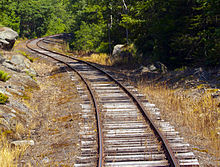Incivil engineering, a reverse curve (or"S" curve) is a section of the horizontal alignment of a highway or rail route in which a curve to the left or right is followed immediately by a curve in the opposite direction.[1][2]


On highways in the United States reverse curves are often announced by the posting of a W1-4L sign (left–right reverse curve) or a W1-4R sign (right–left reverse curve), as called for in the Manual on Uniform Traffic Control Devices.[3]
On rail routes, reverse curves can cause buffer-locking. On the Northeast Corridor in the United States, these also hinder the development of high-speed rail.[4]
This rail-transport related article is a stub. You can help Wikipedia by expanding it. |
This engineering-related article is a stub. You can help Wikipedia by expanding it. |